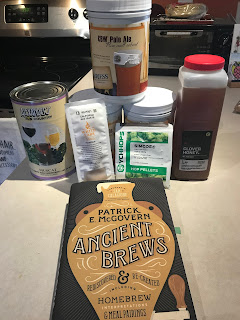For this year's Summer Archaeology Book Club, we'll be reading and discussing
Uncorking the Past: The Quest for Wine, Beer, and Other Alcoholic Beverages by Dr. Patrick McGovern. The book discusses much of McGovern's career-long search for ancient alcoholic beverages from around the world. McGovern, the Scientific Director of the Biomolecular Archaeology Project for Cuisine, Fermented Beverages, and Health, specializes in reconstructing ancient food and beverages based on residues left on ceramics.
As part of his work, McGovern has also ventured into experimental archaeology - specifically working to create ancient beverages with a little help from brewers from around the world. He's worked extensively with
Dogfish Head Brewery to develop and market a series of brews, the
Ancient Ales Series, that bring ancient recipes to life. A second book by McGovern,
Ancient Brews: Rediscovered and Re-Created, details this part of his work through stories on each of the beers and includes recipes for creating home-brewed versions.
Inspired by all of this, I decided to conduct a little experimental archaeology myself! With the help of my trusted brewing associates, Lilli (also an archaeologist) and Gertie (a cat who makes everything her business), we turned my kitchen into an ancient brewery. Well, one with all the modern conveniences.
We decided to make a batch of
Midas Touch, a beer-wine-mead hybrid based on vessels found at the
tomb of King Midas. Yes, that King Midas. The brew's ingredients include malt extract (fermentable sugars in beer), grape juice concentrate (fermentable sugars in wine) and honey (fermentable sugars used in mead). Hops weren't around historically so the original Midas Touch from Dogfish Head uses saffron as a bittering agent. Our brew uses saffron and a small amount of hops.
 |
| Ingredients: Muscat grape juice concentrate, malt extract, clover honey, brewer's yeast, hops and saffron. |
 |
| Brewing supervisor, carefully reviewing the ingredients list. |
 |
| Boiling - an important part of any beer to get the proteins and enzymes right - and to bring out hop flavors. |
 |
| Moving the brew to a secondary fermentor helps condition the brew - and can wake up the yeast to do a little more fermenting. |
 |
| The brew goes into bottles to carbonate and condition some more. Our brewing supervisor made sure we filled the bottles to the correct level. |
Join us on June 4 at 5pm at the FPAN Office to discuss McGovern's work - and taste the fruits of our experiment!
Words and images by Emily Jane Murray, FPAN Staff.




